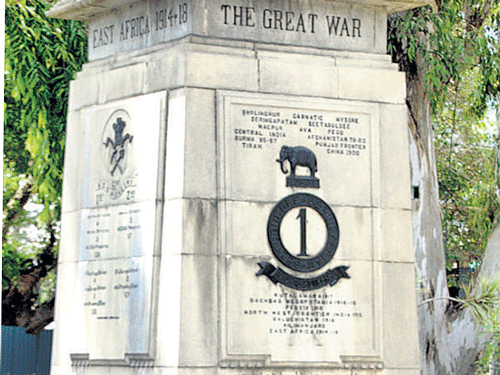The traffic rolls in a great rush down the incline on Residency Road (now Field Marshal Cariappa Road), from St Joseph’s College in the direction of Mayo Hall in Bangalore.
A similar scene unfolds on the perpendicular Brigade Road, though the narrow street forces them into in a slow and noisy procession. The traffic lights at their intersection prevent them from colliding even as they enable pedestrians to dart across without harm.
It is here, to one side of this busy crossroads,and inside a fenced garden, that we see the war memorial ‘Erected by their Comrades in Memory of Officers, Non-Commissioned Officers and Pioneers of the 1st Madras Pioneers who gave their Lives during the Great War 1914-18.’ It is downtown Bangalore’s connect with the First World War, the centenary of which is being observed this year.
The memorial is an elegant cenotaph that blends the traditional European design with the medieval Indian chhatri. The dedication quoted above is engraved on the front side of the memorial, facing the oncoming traffic on Residency Road. It bears the insignia of the Madras Pioneers – an Indian elephant standing on a base inscribed with the word ‘Assaye’.
Below the elephant is a roundel with the word ‘Seringapatam’ on the right arc, the word ‘Seetabuldee’ on the left arc and the numeral ‘1’ inside. Places as far apart from each other as Sholinghur and China, where the regiment was stationed or saw action, are engraved above the elephant.
For history buffs, Assaye – which to the old Bangalorean brings to mind Assaye Road in Ulsoor is in today’s Jalna district of Maharashtra. It was at Assaye that a young Arthur Wellesley, the Duke of Wellington, defeated a much larger Maratha force in the Second Anglo-Maratha War of 1803.
Seringapatam is of course our own Srirangapatna and the reference is to the Anglo-Mysore wars with Tipu Sultan fought in the second half of the 18th century. Seetabuldee is a reference to the Sitabuldi Fort in Nagpur where the British fought the Third Anglo-Maratha War in 1817 against Mudhoji Bhonsle II.
The 1st Madras Pioneers, who erected the memorial, were formed in 1922 and disbanded in 1933. They traced their origins to earlier Pioneer regiments, mainly the 61st, 64th and 81st Pioneers. The role of these regiments was to provide tactical engineering support for the infantry by blasting fortifications, digging trenches and so on.
The remaining three sides of the cenotaph list the three theatres of World War I in which these three Pioneer regiments lost their men. Starting counter-clockwise from the leading side, the Residency Road side remembers the soldiers of the 61st KGO Pioneers (KGO is short for ‘King George’s Own’) who fell in East Africa (approximating to today’s Kenya) during 1914-1918.
The side facing the extension of Brigade Road is dedicated to the 64th Pioneers and reads “Mesopotamia 1916-1918.” “North West Frontier 1915” reads the inscription on the side facing the Catholic Syrian Bank. Each side carries the insignia of the particular regiment and then gives in both English and Tamil the number of British Officers, Indian Officers, Non-Commissioned Officers and Pioneers killed in action.
The memorial appears to be maintained by a leading property developer who has erected another inscription about the soldiers having given up their lives for a better tomorrow. Little did the fallen men of the Pioneers know that the future would unleash more death and destruction in the form of the Second World War.
